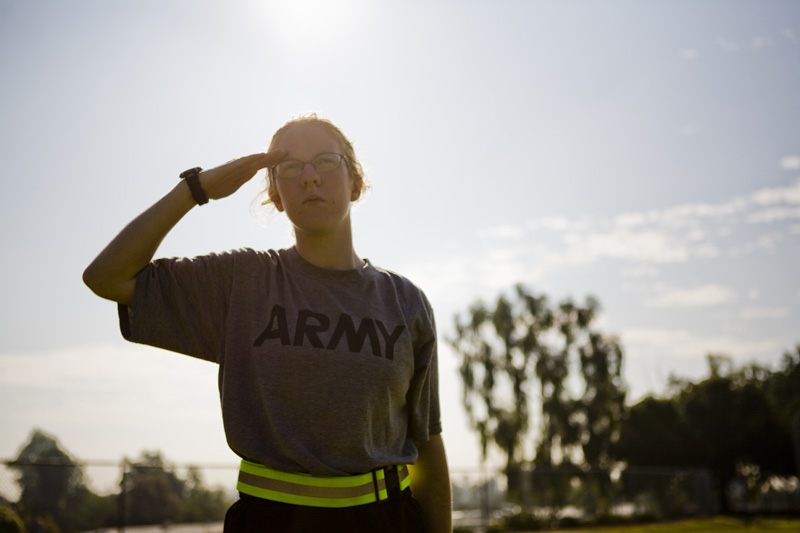While the sun is still down and all her family members are still sleeping, Amanda Ponce, a commuter from Chino, wakes up every Monday, Wednesday and Friday at 4:15 a.m. to arrive on time for her R.O.T.C. (Reserve Officer Training Corps) training at Cal State Fullerton.
Ponce is a sophomore who is pursuing a time-intensive nursing major while training with R.O.T.C. in order to serve full time in the Army following graduation. Ponce is one of 11 Biola women enrolled in the school’s R.O.T.C., representing an increase of women in the program. Women are given the same responsibilities as men, for the most part.
“This morning at our ruck march we all had to carry a 35-pound bag,” said Cadet Rebekah Maxwell, a freshmen studying anthropology. “Plus, another girl and I had to
carry an extra sand bag, so basically we were carrying more than the boys.”
In 2008, R.O.T.C. recruited five females from Biola. Those numbers have increased this year with six new female members, placing enrollment for Biola women in Cal State Fullerton’s R.O.T.C. at 11, the highest on recent record. The 17 male cadets from Biola make for a total of 28 Biola students enrolled in the program, according to Lt. Nelson Varas, the enrollment adviser from the R.O.T.C. program at Cal State Fullerton.
Total enrollment in the program, for men and women combined, also saw a jump from 17 students to 28 students from spring to fall of this year, according Cyndi Cole, a counselor from the registrar’s office. Women’s numbers more than doubled, however, while men’s enrollment went from 12 to 17.
R.O.T.C. gives college students the opportunity to pursue a college degree while training to become an army officer. Students from Biola are eligible for cross-enrollment at Cal State Fullerton, where they train Mondays and Wednesdays at 6 a.m. for one hour. On Fridays they have a lab from 6 a.m. to 3 p.m., which entails both physical training and leadership classes.
In exchange for their service and commitment to the Army, both during school and after graduation, R.O.T.C. students have their tuition and books paid for by the Army. They also receive a $300-$500 allowance per month.
Women at R.O.T.C. are supposedly assigned the same tasks as men and are required to do everything at the same standard, though Ponce said she sometimes has doubts.
Still, Varas, said equal treatment is the policy at R.O.T.C.
“Under the eyes of officers, women and men are equal, they are all soldiers,” Varas said. … Over here female cadets are treated the same way as our male cadets. There’s really no difference. Like this morning, they all did a ruck march and had to carry a 35-pound weight on their backs and a 5 gallon water canteen, and once they got tired, they would take turns. Women are required to do the same tasks as men. There are never comments such as, ‘Oh she’s a woman she can’t do it.’ They are all the same.”
Military females outside Biola are also pursuing military discipline.
For the first time in U.S. history, a woman currently serves as the nation’s top drill sergeant. Command Sgt. Maj. Teresa L. King now leads the Army’s drill sergeant school at Fort Jackson, S.C.
Ponce, however, did recognize that men are generally stronger by nature.
“It’s just a fact, women are not as strong as men,” Ponce said. “I mean there are some girls that are the exception, but other than that, it is scientifically proven that men are stronger; for example, for the ruck marches, most people know that if you have a female in your squad, you are going to be slower.”
According to the book, “Athletic Training and Sports Medicine,” by Robert C. Schenck, from the American Academy of Orthopedic Surgeons, morphologic differences between men and women, particularly body size, fat-free mass and body fat percentage play the largest role in performance differences between genders.
Ponce, however, is living proof that female cadets are capable of accomplishing the tasks of a military cadet, possibly while under even more pressure than men.
Sophomore Sara Newberry, also a nursing major, is in her second year of R.O.T.C.
“I love the discipline and being a part of something greater than myself, Newberry said. “It is nice to feel like I’m giving something back as well as receiving something.”







